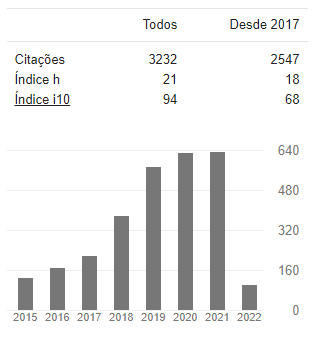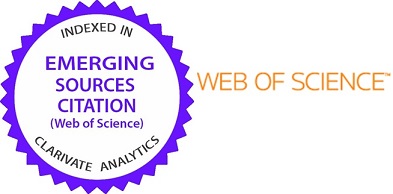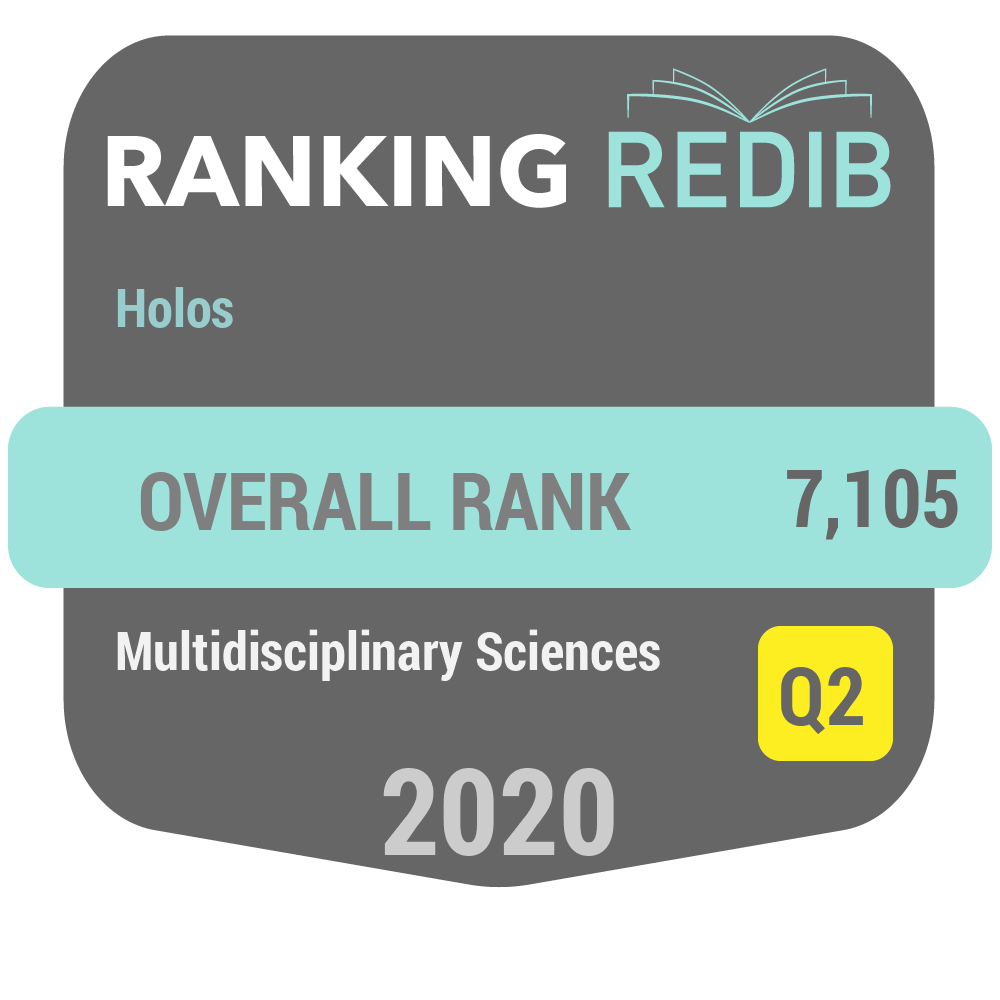CORANTES TÊXTEIS: UMA REVISÃO
DOI:
https://doi.org/10.15628/holos.2013.1239Resumo
A indústria de corantes desenvolve um importante papel na economia do mundo, visto que estes são utilizados em várias atividades fabris. Os corantes têxteis causam especial impacto no meio ambiente principalmente por serem de difícil degradação. Vários processos tem sido estudados a fim de que se consiga realizar um tratamento realmente efetivo em remoção de corantes de efluentes têxteis, entre eles os processos biológicos estão recebendo uma particular atenção por sua eficiência.O tratamento microbiológico de efluentes, especialmente por espécies fúngicas tem ganhado espaço, por estes organismos serem bastante versáteis, tratarem uma grande variedade de tipos de corantes e apresentarem diferentes mecanismos de remoção de cor. Portanto os fungos apresentam-se bastante atrativos e demonstram ser os organismos mais adequados em relação a tratamento de efluentes têxteis.Downloads
Referências
ACEMIOGLU, B. Adsorption of Congo red from aqueous solution onto calcium-rich fly ash, J. Colloid Interface Sci. 274, 2004, 371-379.
AKSU, Z., DONMEZ, G., Combined effects of molasses sucrose and reactive dye on the growth and dye bioaccumulation properties of Candida tropicallis, Process Bioch 40, 2005, 2443-2454.
AKSU, Z., Reactive dye bioaccumulation by Saccharomyces cerevisae, Process Biochem 38, 2003, 1437-1444.
AKSU, Z., TEZER, S., Equilibrium and kinetic modeling of biosorption of Remazol Black B by Rhizopus arrhizus in a batch system: effect of temperature, Process Bioch 36, 2000, 431-439.
AMBROSIO, S.T., CAMPOS-TAKAK, G.M., Decolorization of reactive azo dyes by Cunninghamella elegans UCP 542 under co-metabolic conditions, Bioresource Technol Lett 24, 2002, 1757-1761.
ARCHIBALD, F., Lignin peroxidase activity is not important in biological bleaching and delignification of unbleached kraft pulp by Trametes versicolor, Appl Environ Microbiol 58, 1992, 3101-3109.
BALAMURUGAN, B., THIRUMARIMURUGAN, M., KANNADASAN, T., Anaerobic degradation of textile dye bath effluent using Halomonas sp., Bioresource Technology 102, Krishnankoil, 2011, 6365-6369.
BALAN, D.S.I., MONTEIRO, R.T.R., Decolourization of textile indigo dye by ligninolytic fungi, J. Biotechnology 89, 2001, 141-145.
BANAT, IM., NIGAM, P., SINGH, D., MARCHANT, R., Microbial decolorization of textile dye containing effluents: a review, Bioresource Technology 58, 1996, 217-227.
BECHTOLD, T., TURCANU, A., SCHRORR,W., Eletrochemical decolourization of dispersed indigo on boron-doped diamond anodes, Diamond Relat. Mater. 15, 2006, 1513-1519.
BEZALEL, L., HADAR, Y., CERNIGLIA, CE., Enzymatic mechanisms involved inphenanthrene degradation by the White rot fungus Pleurotus ostreatus, Appl Environ Microbiol 63, 1997, 2495-2501.
ÇETIN, D., DONMEZ, G., Decolorization of reactive dyes by mixed cultures isolated from textile effluent under anaerobic conditions, Enzyme and Microbial Technology 38, Ankara, 2006, 926-930.
CHEN, K., WU, J., LIOU, D., HWANG CJ., Decolourisation of textile dyes By newly isolated bacterial strains, J Biotechnol, 101, 2003, 57-68.
CRINI, G., Kinetic and equilibrium studies on the removal of cationic dyes from aqueous solution by adsorption on a cyclodextrin polymer, Dyes Pigment 77, 2008, 415-426.
CRIPPS, C., BUMPUS, JA., Aust SD Biodegradation of azo and heterocyclic dyes by Phanerochaete chrysosporium, Appl Environ Microbiol 56, 1990, 1114-1118.
FERREIRA, VS., MAGALHÃES, DB., KLING, SH., da Silva, JG., Bom EPS, N-demethylation of Methylene Blue by lignin peroxidase from Phanerochaete chrysosporium, Appl Environ Microbiol, 84, 2000, 84-86.
FU, Y., VIRAGRAVAN, T., Fungal decolorization of dye wastewaters: a review, Bioresour Technology, 79, 2001, 251-262.
GANESH, R., BOARDMAN, GD., TINCHER, WC., Fate of azo dyes in sludges, Water Res., 28, 1994, 1367-1376.
GOTTLIEB, A., SHAW, C., SMITH, A., WHEATLEY, A., Forsythe, S., The toxicity of textile reactive azo dyes after hydrolysis and decolourisation, J Biotechnology 101, 2003, 49-56.
HAI, F.I., YAMAMOTO, K., FUKUSHI, K., Hybrid treatment system for dye wastewater, Crit Ver Environ Sci Technology 37, 2007, 315-377.
HOU, H., ZHOU, J., WANG, J., DU, C., YAN, B., Enhancement of laccase production by Pleurotus ostreatus and its use for the decolourization of anthraquinone dye, Process Biochem. Eng. J. 39, 2004,1415-1419.
ISPICH, 1995, Industrial safety and pollution control handbook, A joint publication of National Safety Council and Associate (Data) Publishers Pvt. Ltd., Hyderabad, 2nd edition, 2nd reprint, 451-466.
KAPDAN, IK., KARGI, F., MCMULLAN, G., MARCHANT, R., Effect of environmental conditions on biological decolorization of textile dyestuff by C. versicolor, Enzyme Microb Technol 26, 2000, 381-387.
KAUSHIK, P., MALIK, A., Fungal dye decolourization: Recent advances and future potential, Environment International 35, 2009, 127-141.
KHELIFI, E., AYED, L., BOUALLAGUI, H., TOUHAMI, Y., HAMDI, M, Effect of nitrogen and carbon sources on indigo and congo red decoulorization by Aspergillus alliaceus strain 121C, Journal of Hazardou Materials, Tunis, 2009, 1056-1062.
KIRK, TK., FARRELL, RL., Enzymatic “combustion”, The microbial degradation of lignin, Annu Rev Microbiol 41, 1987, 465-505.
KNAPP, JS., VANTOCH-WOOD, EJ., ZHANG, F., Use of wood-rotting fungi for the decolourisation of dyes and industrial effluents, In: Fungi in bioremediation, Cambridge, UK: Cambridge University Press, 2001, 242-301.
KNAPP, JS., ZHANG, F., TAPLEY, KN., Decolourisation of Orange II by a white-rot fungus, J Chem Technol Biotechnol 69, 1997, 289-296.
LIAKOU, S. PAVLOU, S., LYBERATOS, G., Ozonation of azo dyes, Wat. Sci. Tech. 35, 1997, 279-285.
LIBRA, J.A., BORCHERT., M., VIGELAHN, L., STORM, T., Two stage biological treatment of a diazo reactive textile dye and the fate of the metabolites, Chemosphere 56, 2004, 167-180.
LOPEZ, M.J., GUISADO, M.C., VARGAS-GARCIA, ESTRELLA, F.S. , MORENO, J. ,Decolourization of industrial dyes by lignolytic microorganisms isolated from compositing environment, Enzyme and Microbial Technology 40, 2006, 42-45
MARTINS, M.A.M., LIMA, N., SILVESTER, A.J.D., QUEIROZ, M.J., Comparative studies of fungal degradation of single or mixed bioaccessible reactive azo dyes, Chemosphere 52, 2003, 967-973.
MASTEN, S.J., DAVIES, S.H.R., The use of ozonation to degrade organic contaminants in wastewaters, Environ. Sci. Technol. 28, 1994, 180A-185A.
MEEHAN, C., BANAT, IM., MCMULLAN, G., NIGAM, P., AMYTH, F., MARCHANT, R., Decolorization of Remazol Black B using a thermotolerant yeast, Kluyveromyces marxianus IMB3, Environ Int 26, 2006, 75-79
MEYER, U., Biodegradation of synthetic organic colorant, FEMS Symp, 12, 1981, 371-385.
MOH ORCIC, M., TEODOROVIC, S., GOLOB, V., FRIEDRICH, J., Fungal enzymatic decolourisation of artificial textile dye baths, Chemosphere, 63, 2006, 1709-1717.
MORAES, S.G., FREIRE, R. S., DURÁN, N., Degradation and toxicity reduction of textile effluent by combined photocatalytic and ozonation processes, Chemosphere 40, Campinas, 2000, 369, 373.
NILSSON, I., MOLLER, A., MATIASSON, B., RUBINDAMAYUGI, M.S.T., WELANDER, U., Decolorization of synthetic and real textile wastewater by the use of white-rot fungi, Enzyme and Microbial Technology 38, Dar es Salaam, 2006, 94-100.
NYANHONGO, G.S., GOMES, J., GUBITZ, G.M., ZVAUYA, R.., Readd, J., Steiner, W., Decolorization of textile dyes by laccases from a newly isolated strain of Trametes modesta, Water Res. 36, 2002, 1449-1456.
O’NEILL, C., LOPEZ, A., ESTEVES, S., HAWKES, F.R., Hawkes, , D.L., WILCOX., S., Azo-dye degradation in an anaerobic –aerobic treatment system operating on simulated textile effluent, Appl Microbiol Biotechnol 53, 2000, 249-254.
Oxspring, DA., MCMULLAN, G., SMYTH WF., MARCHANT, R., Decolourisation and metabolism of the reactive textile dye, Remazol Black B, by an immobilized microbial consortium, Biotechnology Lett 18, 1996, 527-530.
GANODERMAIERI, G., CENNAMO, G., SANNIA, G., Remazol Brilliant Blue R decolourisation by the fungus Pleurotus ostreatus and its oxidative enzymatic system, Enzyme and Microbial Technology 36, 2005, 17-24.
Peralta-ZAMORA, P., KUNZ, A., MORAES, S.G., PELEGRINI, R., MOLEIRO, P.C., REYES, J., DURAN, N., Degradation of rective dyes I: A comparative study of ozonation enzymatic and photochemical processes, Chemosphere 38, 1999, 835-852.
PODGORNIK, H., POLJANSEK, I., PERDIH, A., Transformation of indigo carmine by Phanerochaete chrysosporium lignolytic enzymes, Enzyme and Microbial Technology 29, 2001, 166-172
POINTING, SB., Feasibility of bioremediation by white-rot fungi , Appl Microbiol Biotechnol 57, 2001, 20-33.
PRIGIONE, V., TIGINI, V., PEZZELLA, C., ANASTASI, A., SANNIA, G., VARESE, G.C., Decolourisation and detoxi fication of textile effluents by fungal biosorption, Water Research 42, 2008, 2911-2920.
REDDY, CA., The potential for white rot fungi in the treatment of pollutants, Curr Opin Biotechnol 6, 1995, 320-328.
REVANKAR, M.S., LELE, S.S., Synthetic dye decolorization by Ganoderma sp., WR-1, Bioresourse Technology 98, 2007, 775-780.
RIGAS, F., DRITSA, V., Decolourisation of a polymeric dye by selected fungal strains in liquid cultures, Enzyme Microb Technology 39, 2006, 120-124.
ROMERO, S., BLANQUEZ, P., CAMINAL, G., FONT, X., SARRA, M., GABARRELL, X., VICENT, T., Different approaches to improving the textile dye degradation capacity of Trametes versicolour, Bioche. Eng. J. 31, 2006, 42-47.
ROY, BP., ARCHIBALD, F., Effects of kraft pulp and lignin on Trametes versicolor, Appl Environ Microbiol 59, 1993, 1855-1863.
SUMATHI, S., MANJU, BS., Uptake of reactive textile dyes by Aspergillus foetidus, Enzyme Microb Technology 27, 2000, 347-355.
SWA MY, J., RAMSAY, JA., The evaluation of white-rot fungi in the decoloration of textile dyes, Enzyme Microb Technol 24, 1999, 130-137.
SWAMY, J., RAMSAY, JA., the evaluation of white rot fungi in the decolouration of textile dyes, enzyme Microb Technology 24, 1999, 130-137.
Toh, Y.-C., Yen, J.J.L., Obbard, J.P., Ting, Y.-P., Decolourization of azo dyes by white rot fungi (WRF) isolated in Singapore, Enzyme Microbial Technology 33, 2003, 569-575.
VANDERVIVERA, P.C., BIANCHI, R., VERSTRAETE, W., Treatment and reuse of wastewater from the textile wet-processing industry: review of emerging technologies, Journal of Chemical Technology and Biotechnology 72, 1998, 289-302.
WESENBERG, D., KYRIAKIDES, I., Agathos, S.N., White rot fungi and their enzymes for the treatment of industrial dye effluents, App. Environ. Microbiol. 65, 1999, 1029-1035.
YESILADA, O., ASMA, D., CING, S., Decolorization of textile dyes by fungal pellets, Process Biochemistry 38, Malatya, 2003, 933-938
YESILADA, O., Decolorization of crystal violet by fungi, World J Microb Biotech , 11, 1995, 601-602.
ZHANG, F., YU, J., Decolourisation of acid violet 7 with complex pellets of white rot fungus and activated carbon, Bioproc. Eng. 23, 2000, 295-301.





































